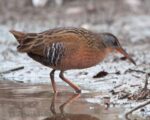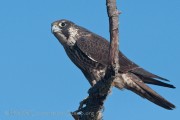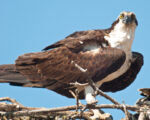Bill and Judee Adams will be sharing pictures from their 90-day spring migration expedition of 2013 when they followed warblers and other songbirds from South Texas up through Ohio and into Southern Ontario, Canada. They saw 38 species of warblers, other songbirds (including tanagers and orioles), owls, hawks, 3 species of Prairie Chickens, and 4 species of rails. They especially enjoyed their experience with the Biggest Week in American Birding at the Magee Marsh boardwalk in Northern Ohio.
Tag: Wintu Audubon
BirdWords: Help out with the Great Backyard Bird Count
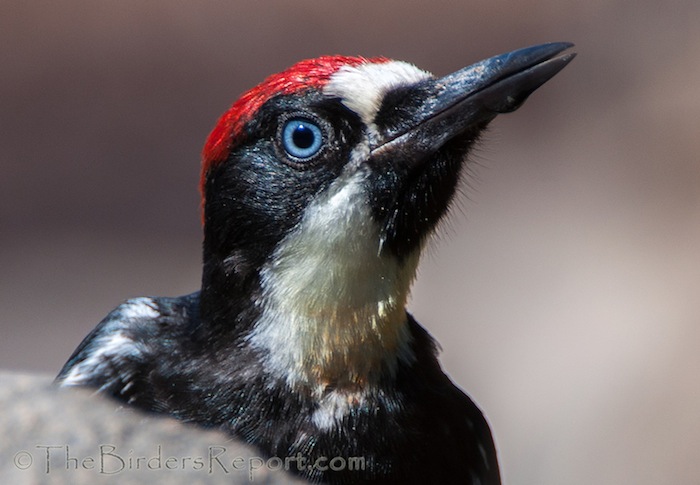
Launched in 1998 by the Cornell Lab of Ornithology and National Audubon Society, the Great Backyard Bird Count was the first online citizen-science project to collect data on wild birds and to display results in near real-time.
Why do we count birds? Because bird populations are dynamic and constantly in flux, no single scientist or team of scientists could hope to document and understand the complex distribution and movements of so many species. This is why citizen science is so important.
Birds are known as sentinel animals. They can detect risks to humans by providing advance warning of a danger, whether it be exposure to a particular hazard (the canary in the coal mine), or changes in the environment (climate change).
Scientists use information from the Great Backyard Bird Count, along with observations from other citizen-science projects, such as the Christmas Bird Count, Project FeederWatch, and eBird, to get the “big picture” about what is happening to bird populations. The longer these data are collected, the more meaningful they become in helping scientists investigate important far-reaching questions like climate change.
The best thing about the GBBC is that it’s easy to do and it’s fun too! The event runs for four days starting February 13th and ending on the 16th. All you have to do is tally the numbers and kinds of birds you see for at least 15 minutes on one or more of the count days, from any location, anywhere in the world! Although it’s called the Great Backyard Bird Count you can count birds, at a nearby park, nature center, your schoolyard, or neighborhood, anywhere you find birds!
In addition to accepting bird observations from anywhere in the world, you can now use the eBird/GBBC program to keep track of your bird life list, yard list, and any other lists which will be automatically stored and updated. You may explore what is being reported by others and you can keep on reporting your birds year round through eBird. Every sighting reported in the Great Backyard Bird Count becomes part of a permanent record that anyone with Internet access can explore.
This year during the GBBC, we’re issuing a call to all of the more experienced birders to introduce someone new to bird watching! Take them out on a bird walk with you or watch feeders together from indoors. Sharing your enthusiasm about birds and showing them how to participate in bird counts is what matters most.
“People who care about birds can change the world,” said Audubon chief scientist Gary Langham. “Technology has made it possible for people everywhere to unite around a shared love of birds and a commitment to protecting them.”
Get all the information you need to participate at http://gbbc.birdcount.org/
BirdWords: Snow Geese Flock to Central Valley
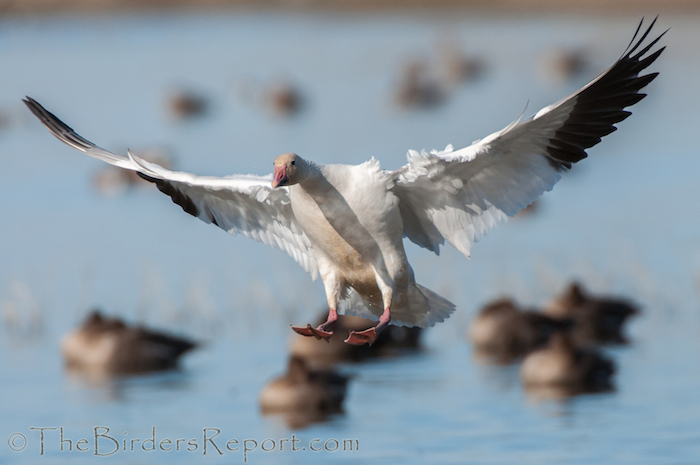
My sister is not a bird watcher, but as she and her family drove back to the Bay Area after a Redding Thanksgiving we received her text: “What’s a big white bird with black wingtips?”
After confirming that they were near Willows and that there were many of the birds we told her “snow geese.”
Small wonder that the birds grabbed her attention. Every winter hundreds of thousands of them, in squealing tornadoes in the sky and squawking blankets over fields and ponds, inundate the Central Valley after nesting in the high arctic, mostly on the islands between Alaska and Greenland.
First the arctic story. The tilt of the North Pole toward the sun in the spring and summer creates a polar season in which the sun never sets, for up to as much as six months right at the North Pole. This abundance of daylight spurs plant growth, in which the grasses, sedges and algae lock great quantities of solar energy into their cells through photosynthesis. That energy is then available to feed geese and ducks and shorebirds by the millions. The birds eat either the plants or the hordes of invertebrates that eat the plants. It’s calorie-rich season, perfect for raising hungry offspring.
Snow geese typically lay a handful of eggs in a tundra tussock, usually in late May. The eggs hatch in some 23 days. Both parents then tend to the young, which follow them about, foraging on their own within a day of hatching. The goslings grow quickly, developing the strength to migrate south in the fall.
Spring snows can disrupt nesting, but mild weather has helped our Pacific flyway geese do very well over the last 10 years. Their numbers grew 53 percent from 2012 to 2013 alone, up to nearly 1.4 million.
In the Redding area, the geese and many arctic nesters find winter habitat at refuges like the Sacramento Wildlife Refuge in Willows. While some 95 percent of original Central Valley habitat has been paved, built upon or turned into farms, the refuges and unburned rice fields help compensate. Many farmers flood their fields through the winter, providing rich grazing and resting grounds that have helped geese thrive, perhaps to record numbers.
However, our drought limits the extent of field flooding both on farms and refuges. The birds, with less water available, squeeze into wherever the water is — a crowded condition that risks spreading disease. For the snow geese, nesting success may be countered with winter die-offs.
Still, in a time when so many species are in decline, the snow geese are flourishing. They remain a sight and sound that harkens to a wilder and inspiring time, and make it well worth a visit to the refuge or at least an open eye as you drive south on Interstate 5.
Note: The Wintu Audubon Society will be conducting a trip to the Sacramento Wildlife Refuge on Jan. 24. See our calendar page for all the information.
Send your bird questions to education@wintuaudubon.org
Sacramento National Wildlife Refuge Outing
This nationally known gem is well worth the 90-mile drive. Enormous numbers of waterfowl fill the sky and numerous impoundments in fall and winter. Snow, Ross’ and Greater White-fronted Geese, Northern Pintails, Northern Shovelers and Gadwalls are assured. Possibilities are White-faced Ibis, Green-winged Teal, Black-necked Stilts and various raptors. We hope to provide 2 way radios to report sightings and alert people in other cars to look for them. Most of the birding is done from cars. Meet at the Redding Convention Center to carpool. Bring a lunch for this full day trip. Bill Oliver will lead.
Lewiston Lake Outing
Lewiston Lake is a reservoir created by Lewiston Dam on the Trinity River just north of Lewiston in Trinity County. It is used for transbasin diversion to the Sacramento River and flood control, as well as for hydroelectric generation. We will visit the California Dept. of Fish and Wildlife Fish Hatchery on the Trinity River. Many raptors and other fisheaters are attracted to the hatchery’s outflow (we spied a bear there on our last visit). Then we will travel up the west side of the lake stopping to scan the lake for ducks and the bordering marsh for passerines. Meet at the south parking lot of the Redding Civic Auditorium to carpool for this full-day outing. We especially invite our Trinity County members to join us. They can meet the Redding group at the Plug & Jug in Lewiston at 8:30 am. George Horn will lead.

